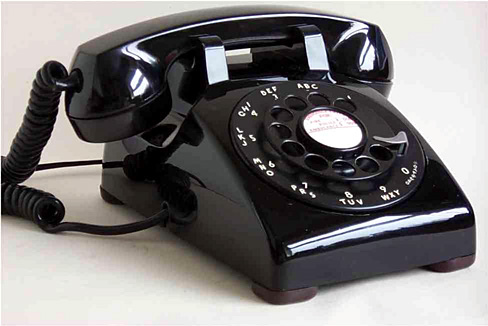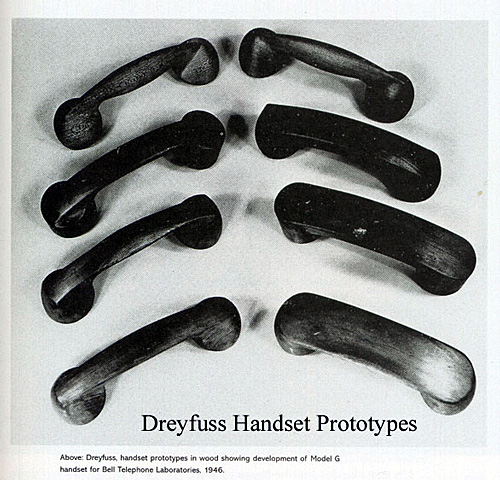February 01, 2004
Designing for People - Chapter 7: The Telephone
Henry Dreyfuss' widest-spread and most lasting design contribution was his work with Bell Telephone, and particularly his work on the 500 Series.

(Taken from here)
There are a few lessons from this chapter. The first is: don't enter beauty contests. When Dreyfuss is first approached by Bell Laboratories about redesigning the telephone, it was as part of a program for artists to conceive the future of the telephone. Dreyfuss declined, insisting that the "appearance should developed from the inside out." Bell at first disagreed, only to return months later with the news that while the other artists offered original designs, they were all impractical.
Such began a remarkably fruitful partnership. Bell Telephone, while perhaps an evil regulated monopoly, deserves some props for their appreciation of good design. They had the insight to hire Saul Bass to redesign their logo in 1969, and to work with Dreyfuss.
Anyway, Dreyfuss presents all the factors that went into the phone design: ergonomics, maintenance, aesthetics. You can read more about it at the National Design Museum's site on "Documenting the Process". And it's worth viewing the evolution of the shape of the handset.

(Taken from here)
The ubiquity of the telephone means that we tend to forget what an amazing design artifact it is. What Dreyfuss could have never guessed was just how wildly popular this design would be -- I can't find the page now, but I came across a statistic of something on the order of 90,000,000 such phones produced. And, as a sign of the design's brilliance, when Ma Bell released a touch-tone phone, the basic shape of the 500 series remained intact.
It's worth going a step back, and thinking about the design of telephone calls. Using a telephone is so simple, we forget how remarkably complicated the process actually is. The genius of Alexander Graham Bell, and the phone system in general, is that they placed all the complexity on the other end of the phone -- at phone switches and the like. The user interface to the phone was made intentionally basic... From party lines (pick up the phone and just talk) to operator assisted calls (pick up the phone and tell the nice lady what you want) to telephone dialing that allowed instant access to pretty much anywhere in the world.
I still use a Bell touch-tone phone. It's got meaningful heft, is easy to handle, and easy to use. The handset evolution photo demonstrates the care that went into the planning. And because it was in Ma Bell's interest that customers never need to replace the phone (since the phone was 'free' with your service), they were designed to pretty much last forever. Compare that to the shoddiness of contemporary phone design -- I've got a Toshiba cordless that pretty much became gummed up in its keypad within just a couple of years.
After the stagnation and then worsening of the landline phone experience, for a brief period, mobile phones served as exemplars of evolving utility -- screens that allowed you to see the number you punched in (helping avoid misdials), address books, microphones that didn't need to be directly in front of your mouth, etc. But, sadly, phone manufacturers have decided that people don't want to make a call on their phone any more, and the resulting interface designs have grown remarkably unwieldy.
For God, Country, and... Starbucks?
Long-time peterme.com readers know of my love for the book For God, Country, and Coca-Cola: The Definitive History of The Great American Soft Drink and The Company That Makes It. The title of the book comes from a letter written by a former G.I., who, in his distress over the release of "New Coke", claims that he fought WWII "For God, country, and Coca-Cola." The book also points out how Coca-Cola followed the G.I.s in WWII to Europe, and how that was the beginning of their international distribution.
This comes up because this morning the paper had an article on how "California Troops Bring Starbucks to Afghanistan." A couple of G.I.s have set up a faux Starbucks in Afghanistan, largely as a morale booster. I guess Coke Isn't It any more.
